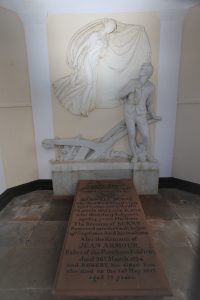
St Michael’s is the oldest church in Dumfries. It is home to the united congregations of St. Michael’s and South and Townhead, with a congregational roll of around 630.
Though the earliest written records go back to the 12th century, it is believed that a Christian church has stood here for over 1300 years. Going back further there is evidence pointing to a sanctuary having been established by St. Ninian (circa 390A.D.) as a stopping place for pilgrims travelling to and from his Candida Casa at Whithorn (This being the first established place of Christian worship in Scotland). Going even further back , as with many other sites on which Christian Churches were built, it is thought that the mound on which our present day church stands would have been a site of Druid worship, long before the Christian era.
The present church is the third church on this site; it is built of local red sandstone and was re-built around the previous church between 1741 and 1746, partly during the time of the second Jacobite rebellion, when the completion of the work was delayed by Bonnie Prince Charlie. The church is now an A listed building and the surrounding churchyard is an A listed historic site. The churchyard contains the elaborate Burns’ Mausoleum, and many other noteworthy memorials, including a Covenanters memorial and a mass grave to those who died in a cholera epidemic.
On entering the church the first thing you notice is the stunning stained glass windows, mainly pictorial, and of a number and size rarely seen in a Presbyterian church; they are reputed to be among some of the finest in Scotland. The ten stone pillars supporting the roof are from the earlier church and date back to around 1500. On one of these there is a brass plaque marking the site of the pew occupied by Robert Burns and his wife Jean Amour.
The pulpit is the original, installed into the newly rebuilt church in 1746; made from Scots fir, it was formed to represent a Communion Chalice, at a cost of £15 10s. The Communion Table is of oak and was presented to the church by the ladies of the congregation in 1903. The chandeliers are the newest part of the building and were installed in 2009, when the church was completely re-wired to meet modern safety standards; they were recommended as the most economic and eco- friendly way to light up the high ceiling area.
St. Michael’s is a galleried church. These galleries were originally known as the Trades Lofts, as when the church was re-built the Incorporated Trades of the town contributed the £80 towards the cost of building them and for this generous contribution they were allocated the privilege of their own seating areas upstairs. Between the north and south gallery, there is our organ loft. The organ is a Willis organ installed in 1890, among much controversy from those who thought church singing should be unaccompanied, and is one of only a few Willis organs still in regular use to-day.
During the second world war, the headquarters for the Norwegian Forces based in Scotland was Dumfries, and St. Michael’s was used as their Garrison church. This connection with Norway is maintained to this day and is marked by two silver plaques, a small one presented by the troops when they departed, and later on a larger one was placed alongside by the Norwegian Consul in recognition of this continuing link.
In January 2009 two small stained glass windows showing Robert Burns and Jean Armour were installed at the rear of the church to mark the 250th Anniversary of the birth of Burns. At the same time the Robert Burns World Federation presented us with a white marble bust of Burns which has been positioned in a specially created niche in one of the church walls. The church is proud of its connection with our national bard, but it is only one part of our long history.
These are only some of the artefacts and points of interest to be found in our historic church. We are open to visitors and of course anyone is welcome to join us for worship on a Sunday morning .